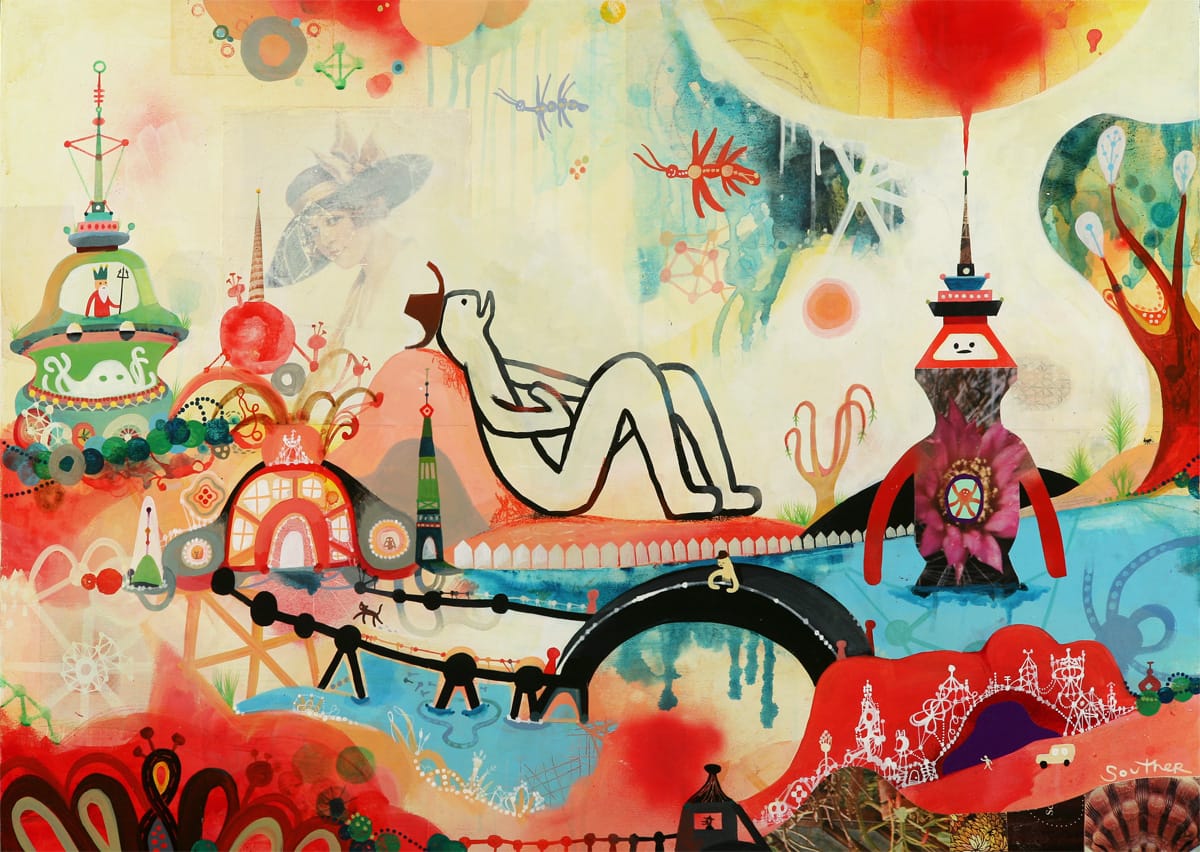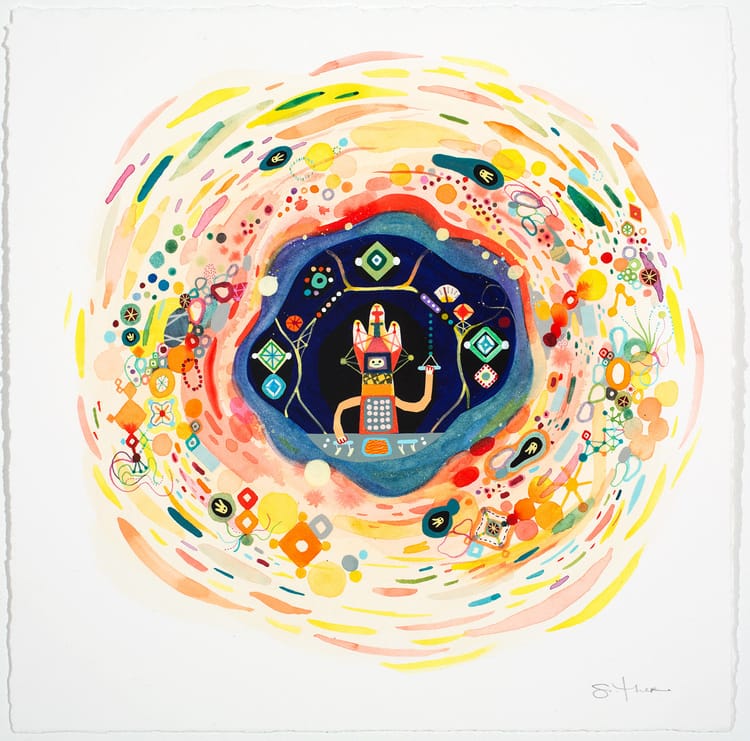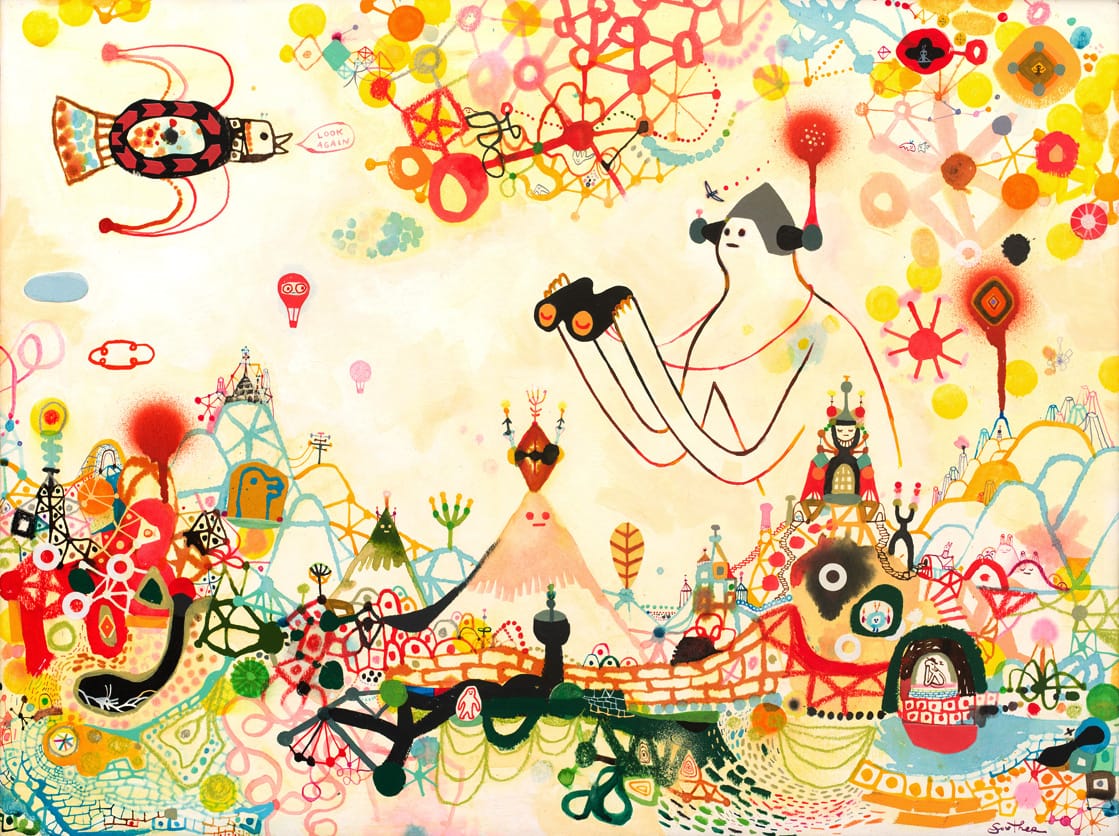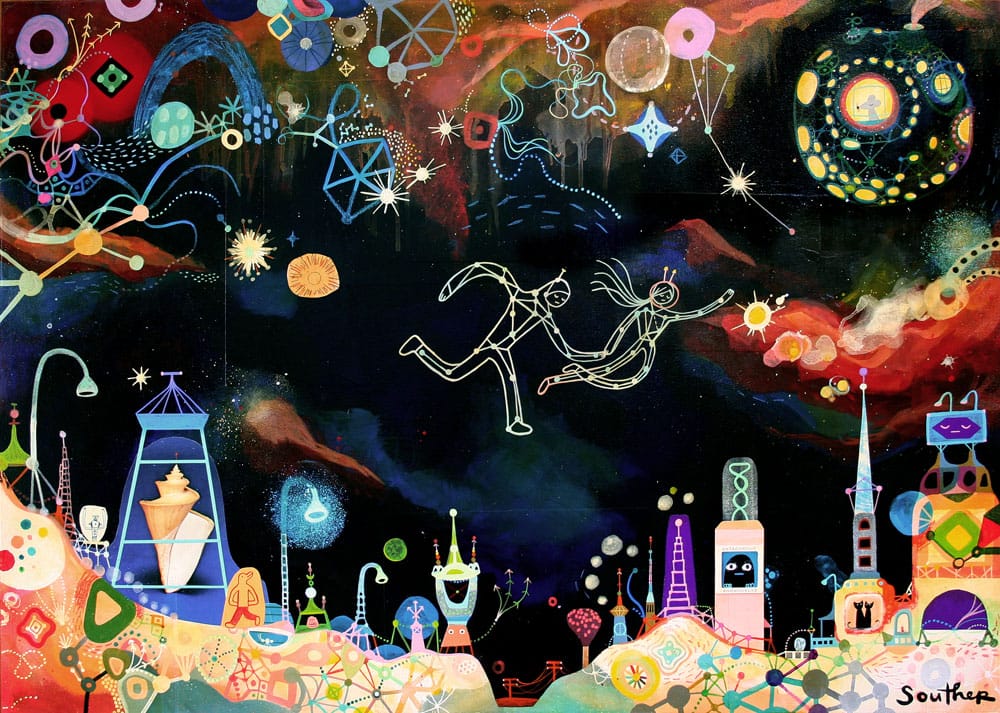Beyond Recognition: The Art of Souther Salazar and the Diagrams of Feeling in a Post-Capitalist Imagination

By J. Owen Matson
In Souther Salazar’s paintings, trains move without arriving and smoke turns into shapes that seem like ideas. Astronauts wear corduroy helmets that seem warm, and queens look calm in dresses made from small pieces of other things. Cats stare at the viewer with interest, and their expressions suggest they know something they do not want to say. Lines connect objects in a way that seems casual, and the connections feel like part of a map that was drawn slowly. The world feels assembled by someone who was alone for a long time and wanted to make something gentle.
Nothing here is ironic, and nothing asks to be explained. The systems feel like they are working, and the emotions stay where they are. Childhood seems like it continued without interruption, and it brought everything it found with it. Paper is used instead of metal, and circuits behave like pets. The atmosphere is calm, and the shapes feel like memories that forgot to leave.
You don’t need to understand the painting, and it doesn’t seem to care. You look at it for a while, and then you want to keep looking. The painting doesn’t speak, and still you feel like it is saying something. Maybe you’ve already been there, and maybe you will go again.

Irony with the Volume Turned Down
Irony usually feels like armor, and it usually shows up with something clever. In Salazar’s work, irony stays soft, and it holds feeling instead of hiding it.
It’s like bubble wrap you don’t want to pop, and it looks like decoration but has a use. You might think it’s just sweetness, and then you see the sadness next to it.
The sadness doesn’t cancel the joy, and the joy doesn’t erase the sadness. Both move quietly, like trains that don’t need to arrive.
The Bee Queen looks large and quiet, and she stands in a way that feels like waiting. Her arms reach out like they’re searching, and her dress holds colors like maps.
Two black cats are next to her, and they look like they know her history. She seems strange and beautiful, and neither feeling needs to be more true.
This is the place Salazar returns to, and it’s not between things but made of how they sit together.
It feels like a joke and a ceremony, and neither one needs to explain the other. It opens itself, and then it stays open.
The machines don’t act like machines, and they don’t ask for anything. The screens feel like dreams, and the robots look like they’re resting.
Nothing in the future here feels sharp, and nothing tries to show you what will happen. The technology just hums a little, and it wants to stay near.
Diagrams of Feeling
In Salazar’s universe, everything is connected, including things that probably shouldn’t be. A chair is connected to a cloud, and a sandwich might be connected to a feeling about third grade.
Lines drift across the canvas like they got distracted halfway through, and then decided that was fine. Tiny bridges appear between buildings that don’t have doors, and nobody seems worried about it.
The wheels turn without going anywhere, and nobody asks them to stop. Joy operates a pulley system, and grief climbs a ladder wearing socks with little moons on them.
Hope sits in front of a switchboard labeled “EMOTIONAL SETTINGS” and keeps pressing buttons that don’t do anything obvious.
The paintings feel like they’re thinking, but maybe just about snacks or someone they forgot to text back. A tiny city forms out of buttons, glue, and maybe a spoon that someone stepped on in 1998.
You wonder if the paintings are watching you, and then you wonder if they’re judging your haircut. Maybe they are trying to make meaning, or maybe they just like string.
It doesn’t feel efficient, but it feels like it cares.
This isn’t cold design, unless your feelings are cold and shaped like toast. It’s more like tissue paper that accidentally became sacred.
A memory turns into a bridge, and a forgotten emotion becomes a weird little tower made of cardboard and affection.
Everything looks like it was built by someone who ran out of materials and just said “this is good,” and somehow it is.

The Serious Work of Play
Calling Salazar’s work playful doesn’t mean it isn’t serious, and doesn’t mean it’s trying to be serious either. It just seems to remember that meaning doesn’t have to knock—it can show up quietly, wearing socks that don’t match and holding a kite made of old receipts and one lottery ticket that was never scratched.
The paintings don’t explain much, and they don’t seem upset about it. They ask you to help, using what’s around—some glue, some old thoughts, maybe a sticker shaped like a frog.
This feels like thinking, but also like coloring while waiting for something to cook. It doesn’t pick between emotion and analysis, and it doesn’t ask you to either.
Salazar makes play seem like a real tool, and not just something that happens by accident. It works like a sentence that starts with a question and ends with a drawing of a boat.
A lot of it feels like wondering out loud, slowly, while sitting on the floor. The kind of wondering that doesn’t need answers, and maybe doesn’t even want them.
It just wants to keep being wondered about, maybe while holding a snack.
There isn’t a final shape in these paintings, and there isn’t a system that explains the rest. What there is feels like staying.
There’s color that keeps repeating with tiny changes, and lines that act like they don’t know where they’re going.
Each part leads somewhere, but maybe that’s not the point, and maybe the point is just watching how the pencil moved.

Tiny Worlds, Built by Feeling
Start with The Signal. A glowing orb radiates from a structure that is part observatory, part lantern, part head. Around it extend antennae—or branches—or neural pathways, depending on how you squint. Inside, a figure sits quietly, possibly watching a screen, possibly just existing. Surrounding them: a city, or a forest, or a machine, humming gently, connected by bridges and tendrils of light.
What is the signal? It isn’t loud. It doesn’t demand interpretation. It glows. It arrives through atmosphere, not instruction. It is felt before it is parsed. This is Salazar at his most careful and his most generous: suggesting that the messages that matter most aren’t transmitted with force, but shared ambiently—like warmth, like attention, like care.
In Half Asleep, we enter a landscape that might be dream, might be memory, might be myth. Tiny boats drift beneath roots that dangle midair. Creatures hover in states of transformation. At the center floats a being—part bear, part human, part constellation—eyes closed, cradled in a vessel stitched together from something that feels like time folded gently.
The beauty of Half Asleep is in its refusal to arrive. It stays within the drift, honoring the murky, slow space between sleep and waking. In a world that craves clarity, this painting trusts the power of what resists resolution. It suggests that some states—dreaming, healing, becoming—are not problems to solve, but intervals to inhabit.
And then there’s Bee Queen. The painting feels ceremonial. The Queen is adorned, mapped like a planet, seated at the center of a realm where every pattern counts and every figure holds meaning. The cats nearby are mischievous but devoted. The geometry is a little off, but lovingly so. There is humor here, but it is reverent—irony that has been bent, not toward critique, but toward affection. She is not mocked. She is mythologized.
Even in a small collage like IMG_9509, Salazar’s ethos holds. The image feels like a gathering of fragments—half-doodles, ghosts of comics, scraps from the edges of notebooks. It’s unfinished in the way the best thoughts are unfinished: still turning over, still becoming, still thinking themselves even after you’ve walked away.
The Signal
At first glance, The Signal reads like a diagram for a benevolent machine—the kind built not to extract, but to glow. Its structure feels architectural: a central tower, radiating limbs, a sense of symmetry that emerges more than it insists. At the center, a figure sits within a form that could be a head, a lighthouse, or a heart wrapped in scaffolding. Above, satellite-like or botanical extensions reach outward into a network that resembles constellations, or thoughts, or both.
And yet, despite its circuitry, this is not a painting about technology—at least not the kind we’ve come to expect. There are no tangled wires, no chrome, no friction. Instead, there are roots. There are rhythms. There are conduits that carry meaning the way breath carries warmth. This is a machine assembled from feeling. The central light pulses like a chest full of remembered presence, or a message from someone trying, gently, to be known. Its glow doesn’t shout. It listens.
This is Salazar’s vision of sentience: not control, but care rendered into form. The signal is not data. The signal is attention. And attention, here, has infrastructure—it’s scaffolded, cultivated, sustained. The figure does not deliver a message. The figure is the message.
Half Asleep
In Half Asleep, narrative doesn’t unfold—it drifts. A being floats in a tiny boat, eyes closed, part bear, part boy, part constellation. Below, roots hang into an ether that could be water, or sleep, or something unnamed. Around the boat, a quiet flotilla of creatures and objects migrates with no urgency but with intention. This isn’t a journey toward arrival. It’s a mood moving across time.
The bear-boy doesn’t steer. He isn’t fully awake. That’s exactly the point. This is the dream-state not as escape, but as a form of intelligence. A space where the unconscious doesn’t sink beneath thought but travels alongside it, ferrying us gently through invisible waters.
Salazar paints the unconscious with dignity. Not as chaos, but as soft logic—the kind where boats float on air and memories grow limbs. The entire scene is held in pale blues, soft whites, warm rusts: tones that suggest fragility, safety, dusk. The figures are not alone. They’re together in quiet relation, with no need for drama. There is no spectacle here. Only process.
To be half asleep in this painting is to be fully immersed in becoming.
Bee Queen
She is shiny and symmetrical, and maybe slightly too calm for a person with two cats staring at her. She stands in the middle like she built the room, and now she’s just waiting for someone to notice.
Her dress looks like a galaxy made from fabric scraps, and her head looks like a math problem someone gave up on. The cats are sitting nearby, and they seem like they just told a joke telepathically.
She doesn’t feel like a joke, and she doesn’t feel like a queen in a regular way. The painting doesn’t explain her, and she doesn’t explain herself.
There are bubbles and stars around her, and they seem like they’re doing a job. Something about the scene feels scientific, and also like something you’d draw while on the phone.
The gown might be tracking data, and the data might be about bees, or maybe feelings about bees.
The cats stay quiet, and they seem fine with everything. The shapes float near her without touching, and they look like they’ve been floating a long time.
Even irony seems a little confused, and decides to just sit down and be polite.
Salazar lets her be silly and important, and he doesn’t make a big deal about it. The painting feels like it knows she matters, and also knows that everyone wears pajamas eventually.
Maybe the point is that power and kindness both wear funny outfits sometimes, and maybe that’s why she looks comfortable.
IMG_9509
This piece feels like walking through someone’s memory palace while they’re still figuring out where the walls go. It’s not really a world yet, and it’s not a story either, but it seems excited about maybe becoming both.
Figures float around like they forgot what they were doing, and some of them look more committed than others. There’s a bear wearing a hat, and he seems busy. There’s a house on stilts that looks like it’s thinking. A flying creature is nearby, and it seems like it might be having an idea.
It’s a collage, but it doesn’t try to be neat, and nobody seems worried about alignment. It’s more like a cosmic scrapbook that got bored and wandered off.
Ink shows up, and then paint joins in, and then someone possibly taped something down and forgot why. Some lines look like doodles, and others look like decisions that felt right in the moment.
There’s writing, or almost-writing, and some of it seems like it’s in a language made up five seconds ago during a nap.
The power comes from how nothing is done, and nothing feels like it wants to be. The piece doesn’t ask for anything except maybe that you keep looking at it slowly.
It lets you notice something and forget it at the same time, which feels relaxing. You might ask “What’s this little guy doing here?” and then immediately get distracted by a speech bubble or a fish with legs.
This is process as an aesthetic decision, and also maybe just what happens when you don’t clean your desk for a week. The image isn’t finished, and it doesn’t seem to mind.
It lives somewhere between drawing and memory, and also near the part of your brain where old cartoons live.
Somewhere in the middle of all this is a zine ghost, or a napkin that turned into a universe by accident. And Salazar seems to be saying, in a whisper, “You don’t have to understand anything to feel okay about this.”

Cartography of Feeling: A Speculative Afterglow
Taken together, Salazar’s works don’t form a story, and they don’t really ask to. They aren’t puzzle pieces, and they aren’t chapters—they feel more like stars that got close enough to wave.
The Bee Queen stands around like she’s waiting for something important, and Half Asleep floats nearby like it forgot its schedule. The Signal keeps humming softly in the background, like a toaster that developed self-awareness.
Even IMG_9509 seems busy, with its scraps acting like notes passed between dimensions by someone who doodles during meetings. None of them explain each other, but they all seem fine sharing the same room.
What does this emotional neighborhood believe in? It doesn’t reward knowing everything, and it doesn’t seem interested in control. It prefers relation—especially the kind that’s awkward but still nice.
Salazar’s characters don’t conquer their environments, and they don’t run away either. They just live inside them, like they’ve agreed to help out a little.
They sit inside things that look like houses or hearts or possibly brain-shaped greenhouses. They drift around, check on stuff, maybe think about snacks.
They’re not trying to win; they’re just trying to notice.
This isn’t escape, and it’s not some big heroic vision either. It’s more like re-entering the part of your brain where machines are friendly and irony doesn’t have to be exhausting.
Salazar builds systems that care quietly, and figures that seem fine not knowing what to do next. He makes joy feel like something you assemble with tape, string, and leftover kindness.
His work feels like a map made of feelings, and none of the roads are labeled. It doesn’t care about scale, and rivers might be made of laughter if that’s what was available.
The stars aren’t pulled together by gravity—they just like being near each other.
Living with these pieces reminds you that some things don’t need to finish. They keep vibrating a little, like a song you half-remember.
Meaning happens slowly, like light from a quiet signal that was sent a long time ago by someone who hoped you’d still be listening.

Against Recognition: Salazar’s Post-Recognitive Ethos
This essay introduces the concept of post-recognition aesthetics to describe a visual and affective mode that operates outside the logics of visibility, legibility, and affirmation that structure contemporary platform capitalism. Through a close reading of Souther Salazar’s visual practice, the essay traces how care, relation, and presence are rendered infrastructurally rather than expressively. Figures in Salazar’s work do not perform interiority or solicit attention; instead, they dwell within diagrammatic systems that model sustained adjacency, ambient connection, and affective holding. In contrast to aesthetic modes that rely on legibility, critique, or assertion, post-recognition aesthetics establish ecologies of attention that neither withdraw from politics nor appeal to recognition as a condition of participation. By situating Salazar’s practice within debates on visibility economies, affective labor, and anti-ocular epistemologies, the essay argues for a recalibration of aesthetic value around presence without performance and connection without capture.
To engage with Souther Salazar’s work is to enter a visual field defined not by resolution, but by persistence. His compositions do not build toward climax, completion, or symbolic closure. Instead, they establish environments in which meaning circulates without seeking stabilization. The images develop slowly, across layered planes of form, rhythm, and gesture, inviting the viewer to remain in proximity rather than pursue conclusion. This sustained attentional mode positions Salazar’s work within a broader set of aesthetic practices that foreground relation over representation, movement over messaging, and presence over articulation.
The visual languages that emerge in Salazar’s paintings take shape through figures embedded in systems—assemblages of lines, patterns, lights, and structures that evoke both technological diagrams and organic ecologies. These systems register not as mechanisms of function or control, but as mediators of connection. Figures drift, dwell, or rest within these spaces, shaped not by narrative development or expressive affect but by the quiet coherence of co-presence. Their gestures are minor but continuous, structured by an attentiveness that is not directed toward an audience. What results is a formal vocabulary attuned to collective inhabitation, in which significance is distributed across the entire composition rather than concentrated in the subject.
This aesthetic orientation has significant implications for how we understand the relationship between visual culture and contemporary political economies. In an era governed by metrics, platforms, and algorithmic visibility, value is often assigned through systems of recognition—structures that convert identity, affect, and attention into legible outputs. Recognition operates as a condition for social and economic participation, translating presence into data and affect into currency. Within this context, visibility becomes a site of both opportunity and extraction. The rendering of self, gesture, or emotion into communicative display is increasingly shaped by logics of optimization and capture, where to be seen is to be subject to assessment.
Salazar’s work engages these dynamics not through negation or critique, but by establishing an alternative epistemology of relation. What his paintings make available is a form of presence that does not require recognition in the conventional sense. The figures in his work are not offered up for identification, and their value is not contingent upon clarity, expressiveness, or communicability. Their relation to the viewer is not structured by performance but by adjacency—by a proximity that holds without demanding reciprocation or interpretation. In this way, Salazar’s images build a conceptual space for what I term a post-recognition aesthetic: a visual and affective mode that configures meaning without requiring visibility, affirmation, or legibility as conditions for relation.
A post-recognition aesthetic does not suspend political commitment; rather, it reconfigures the terms under which political and affective life are made perceptible. In place of visibility, it foregrounds infrastructural forms of care—lines, bridges, patterns, and rhythms that sustain relation without orienting it toward display. These aesthetic systems do not register as affective statements but as environments of holding, in which emotion, presence, and attention are maintained without narration. Importantly, these forms of care are not supplemental to the image; they are embedded in its material logic. Pulleys, signals, pathways, and constellations carry out the work of mediation, not as metaphors but as operative structures.
The figures within these systems do not stand apart from them, nor are they absorbed entirely. They remain partially withdrawn, half-turned, or indistinct—not in order to signal mystery or resist comprehension, but to affirm the possibility of relation without full exposure. Their quiet persistence invites a mode of viewing grounded in patience and attunement rather than extraction or resolution. In this sense, Salazar’s work functions as a refusal of the recognitive imperative that structures much of contemporary visual and social life. It neither subverts nor replicates the logic of visibility. It operates in a different register altogether.
Within late capitalist culture, recognition increasingly serves as a mechanism of governance, shaping access, belonging, and value. From the performative labor of social media to the instrumentalization of affect in workplace and educational contexts, to be seen is often to be measured, and to be felt is often to be formatted. Salazar’s work intervenes in this economy by constructing visual ecologies that remain relational without requiring translation into data, narrative, or identity. These are not spaces of refusal or escape, but of ongoing composition—of aesthetic environments in which relation is possible precisely because it is sustained without resolution.
To remain with these works is to enter a field of soft resistance—an attunement to form, color, and structure that neither resolves nor withdraws. Salazar does not propose an alternative ideology or counter-narrative. He models a shift in perceptual ethics. Through an attentional logic that privileges process, subtlety, and infrastructural care, his paintings instantiate a politics that does not derive from assertion or critique but from the quiet reconfiguration of relation itself. A politics of showing up without showing off. A politics of presence without performance.
This aesthetic modality resonates with, yet departs from, adjacent frameworks such as relational aesthetics, which emphasize participatory sociality, and post-digital visual culture, which interrogates the collapse of medium specificity under conditions of ubiquitous computation. While Salazar’s work shares affinities with these traditions, it advances a distinct proposition: that relation can be aestheticized without being operationalized, and that visual systems can register care without staging it as content. His practice also intersects with anti-ocular epistemologies, which critique the dominance of vision as the primary mode of knowledge production. Yet rather than displace vision, Salazar reorients it—away from capture and toward a slower, less extractive form of sensing. By foregrounding co-presence, infrastructural attention, and affective atmospheres, Salazar’s work contributes to an emerging post-recognition visual culture, in which value is not produced through affirmation, but through the quiet labor of maintenance, adjacency, and shared duration.